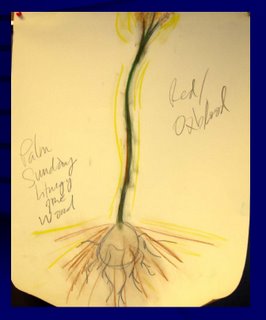Thursday, August 31, 2006
Recommended Reading on Genesis and/or Exodus
Ark of the Covenant, Post 4
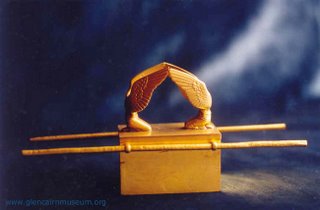
The symbolic association of God and the ark was developed in another direction by the theological tradition that we find in such Scriptures as Isaiah and the PT strand of the Pentateuch. This biblical theology finds it too anthropomorphic to think of God permanently seated upon the ark, dwelling in the temple as a human would live in a house. God is totally other than humanity.
God's appearances at the ark are episodic and transient. God speaks from between the cherub statues on the ark, not as a humanoid seated above them (e.g., Exod 25:22; 30:6, 36; Lev 16:2 PT). God’s appearing is marked by opaque clouds and burning flames. There is no visible image involved whatsoever (e.g., Lev 9:23–24; 10:2; 16:2 PT).
For visual art to represent the Holy, this theology claims, it must use negative means. A sense of ineffable mystery is best conveyed by pure space, vaulted absence, and eerie vacancy. The cherubim’s wings must frame such space.

As with yesterday's post, this symbolism is also attested by archaeology. Here is a tier from the Taanach cult-stand, showing two cherubim framing a completely empty space, representing God's mysterious, numinous otherness. They powerfully present us with a palpable emptiness. They direct our gaze past all human experience toward the Beyond.
Wednesday, August 30, 2006
Ark of the Covenant, Post 3
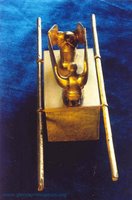 In several key theologies in the Bible, the ark is closely associated with the presence or appearance of God. Because of God's powerful otherness, it is kept in the innermost holy place of the temple, the adytum or "Holy of Holies."
In several key theologies in the Bible, the ark is closely associated with the presence or appearance of God. Because of God's powerful otherness, it is kept in the innermost holy place of the temple, the adytum or "Holy of Holies." In one set of these biblical traditions, the ark forms a symbolic stand, throne, or chariot for God. Both Psalm 80:1 and Psalm 99:1 speak of God sitting enthroned upon the cherubim. The poetic image was familiar in the ancient Near East. Here is an ivory carving from Canaanite Megiddo, showing a king sitting enthroned upon a cherub throne:

This understanding of the ark is most developed in Ezekiel and the HS strand of the Pentateuch, where not God, God's self, but God's "glory" permanently dwells atop the ark. For examples, see Ezekiel 1:26 and Exod 25:8; 29:45–46; Lev 26:11, all HS.
The neat thing in this theology is that God is wondrously present in the midst of God's people, who emulate God's holiness and are magnificently transformed by it. (See Lev 11:44; 19:2; 20:7. 26, all HS; Ezek 37:24; 43:9.) From the midst of Israel, God radiates the divine holiness out to the entire land and to every sector of society.
Tuesday, August 29, 2006
The Ark of the Covenant, continued

The cherubim are far from the baby faced angels that many people imagine. They are rather untamed, archetypal, composite beings that tend to array themselves about an archetypal cosmic center. From archaeology we know that they were sphinxes, winged bulls or lions. In Israel they were most likely thought of as bovine. Above is a relief of one of them at the ancient temple of 'Ain Dara, Syria. (The photo is courtesy of my former student, Laura F.)
The recent production "Exodus Decoded" suggests another piece of archaeology images the ark. A small gold relief from Mycenae, now at the Athens Museum fascinatingly depicts two animalistic beings atop a cubic structure or platform, perhaps guarding an entrance ramp and /or an altar.

The image certainly enlivens one's imagination. However, one need not posit a direct connection between the iconography here at Mycenae and the iconography of the Israelite ark. As I said, the cherubim are cross-cultural archetypes, part of all our collective unconscious minds. Could cherubim sometimes have the face of a bird? See Ezekiel 1:10; 10:14.
As always, comments and further observations are welcome. I plan to continue this series for at least two more days.
Monday, August 28, 2006
Imagine Finding the Ark of the Covenant...

Here is the appearance of the biblical ark of the covenant as presented by the creators of "Indiana Jones and the Raiders of the Lost Ark." The image is actually pretty close to some of the biblical descriptions of the ark. (Interestingly, though, the OT may contain more than one tradition as to what the ark looked like.) On the blog this week, I'm planning to present some posts unearthing the nature of the ark in more detail, so stay tuned...
Neat Movie Clip:
"Top Men Working on It" is the memorable final scene from the above mentioned movie, "Raiders of the Lost Ark." The clip was posted to YouTube on July 10, 2006. Whenever I see this scene, I'm reminded that in real life some of the greatest archaeological finds illuminating the Bible were actually not made out in the field, but in the bowls of the British Museum! It's true.
Sunday, August 27, 2006
Update on the End Times!

Update at a distance of one month: Newsweek's article on the end times from almost exactly one month ago remains the most blogged about of their online pieces, with 76 blogs currently discussing it. You'll remember that the column consisted of an interview by Brian Braiker of Tim LaHaye, one of the authors of the "Left Behind" series. It is entitled: "Are These the End Times?"
I'm sad to report that all this interest in LaHaye, which Newsweek has generated, does not seem to have produced a landslide of sales for my book, The Apocalyptic Literature, which actually offers a sane interpretation of these passages of the Bible. I think that I will have to leave now and go cry into my pillow...
There is an unconfirmed rumor in the blogosphere that LaHaye is secretly forging an additional lost gospel so as to add a 67th book to the scriptural canon. This will allow LaHaye to expand his Left Behind series by another twenty books or so, guaranteeing his multimillionaire status will only improve.
Psalm 16 (Year B, Proper 16; 12 Pentecost)

The lectionary presents us with Psalm 16 for consideration today. There are many fascinating riches here, not least of which is v. 5, "LORD, my allotted portion and my cup, you have made my destiny secure" (NAB).
The psalmist is describing the beauty of his spiritual inheritance using the imagery of land inheritance in Israel. At the settlement of the land, the LORD gave each family-line a permanent homestead within the promised land, the specific portion determined by sacred lottery (cf. Joshua 14:1; 19:51). The homestead provided stability and prosperity, a secure destiny. Naturally, the lottery was kinder to some familes, who were "luckier" than others.
The psalmist considers it very "lucky" to have the LORD as a direct source of this sort of stability and security. But beyond this, v. 5 suggests that it's not just chance or luck that landed the psalmist in this blessed state. God's fingers are somehow in the lottery! "You hold my lot" (NRSV).
God is at work to secure God’s servants’ destinies, but often behind the scenes, in a patient way that respects human choices and natural processes. God does not normally do this sort of work through miracles or magic, and, tragically, there are apparently some very real limits to what is possible, even for God. Nevertheless, the world is apparently a supple and flexible medium, where divine providence may operate in hidden, beautiful ways.
As always, reflections and comments are welcome.
Saturday, August 26, 2006
Neat Link: The Tabernacle
 Under the category of neat links, there is a good looking model of Israel's wilderness tent
Under the category of neat links, there is a good looking model of Israel's wilderness tentsanctuary at the Glen Cairn Museum WebSite. The model attempts to reconstruct the tabernacle based on its biblical descriptions in the Pentateuch, where, by the way, it receives more verses devoted to it than to any other object. According to the biblical description, the tabernacle contained the ark, an incense altar, a table, a seven-light menora, an eternal light, Aaron’s staff, the vessels that are used by the priests, a container of manna, and a scroll written by Moses.
There is a neat QuickTime movie about it all that is rather fun to watch. To see the movie, click here.

Friday, August 25, 2006
A Fascinating Dialog with Dan Trabue on the Two Testaments
 Dr Cathey's BlogPost: Scriptural Surgery? - Jim West Style!
Dr Cathey's BlogPost: Scriptural Surgery? - Jim West Style!In the "Comments" to this particular posting, Dan Trabue has raised important questions of biblical theology that highly interest me.
I think we are going to try to continue the discussion over here in my blog for a little while.
Meanwhile, here is a bit of the recent discussion:
Cook: Dan, the stance you defend is widespread, but I cannot agree with it. It fails to hold the two testaments of the Christian Bible in dynamic tension. Let me cite one of the examples that Brevard Childs himself gives us: Moses' violent murder of an Egyptian. The NT takes a clear non-pacificist stance on the act. Hebrews 11:24ff. praises Moses' decisions in Exodus 2. On the other hand, the OT is more ambivalent and perhaps more practical. The OT neither faults nor praises Moses, but presents a narrative in Exodus 2 that shows how both negative and positive results follow from his violence. I do not think that the NT view supercedes the OT view here, but believe that both views are instructive for us. From the OT side, I take away the truth that if in Christian faith I choose to do violence, I must be ready for both positive and unexpectedly negative results to follow.
Dan Trabue: I agree that both OT and NT are instructive to us. But it seems to me that in some places there are clear decisions that we have to make - will we go with the OT command or the NT command?
Do you eat pork or shrimp (as allowed in the NT) or do you NOT eat pork/shrimp (as commanded in the OT)? There are two opposite opinions offered here as to what's allowed and what's not. It seems to me, we either have to embrace one or the other, or ignore both (say, for instance, "I don't eat either pork or shrimp, but I do this for health reasons, not because of what the Bible does or doesn't say.")
I'm honestly curious: What do you do with places where it seems that we're commanded to do two opposite things? Do you turn the other cheek or seek an eye for an eye?
Dan Trabue: As to your Moses example, Stephen, I think it is a huge stretch to say that the NT takes a non-pacifist position in the book of Hebrews because it doesn't condemn Moses' murdering an Egyptian. Does the fact that the NT calls David a "man after God's own heart" (Acts 13) mean that Luke is endorsing adultery, cowardice, murder and lying? God forbid!
As I said, I love the OT, but I weigh everything that the Bible says against Jesus. This used to be standard Baptist teaching ("We interpret the Old Testament in light of the New Testament and the whole Bible in light of the life and teachings of Jesus Christ as revealed in Scripture"), as well as many other faith traditions, I'm sure.
To say this is not to dismiss the teachings of the OT, but rather to realize that Jesus came to fulfill the law. To give us a more complete understanding of God's word. Additionally, we have to keep in mind that much of the OT is offered in a historical vein, but not necessarily as a universal and eternal teaching that is to be passed down forevermore.
I'm sure you don't embrace stoning to death disrespectful children or "men who lay with men." I'd hope that you don't think we ought to slaughter an entire enemy as sometimes depicted in the OT, down to their children and puppies.
We don't embrace these teachings because we've been given better, more complete understanding of God, don't you agree with this?
Or, if not, how do you explain that we don't continue to embrace all the teachings of the OT? With the possible exception of dietary laws and treatment of enemies, there is no place in the NT that specifically says we can STOP killing disrespectful children.
Cook: No, Dan, but Hebrews 11 is definitely non-pacificist----e.g., v. 33 "by faith they conquered kingdoms." I'm not saying we should only read Hebrews 11 and each one of us become a non-pacifist, just that we should also be willing to hear the witness of OT texts in dynamic interaction with Hebrews 11---OT texts such as Exodus 2.
Dan, thank you for engaging these questions. The discussion is highly significant and of great interest. I think this will be my last post here, since it's Joe's blog and I don't want to hijack it. You're welcome to continue it on my blog ifyou'd like. Let me reply to your two posts. I enjoy debate, and offer these remarks in a spirit of Christian friendship.
Dan, in my humble opinion several of your gut instincts are very much on target: Christians have the NT, Jews have the Mishnah and Talmud----thus, most Christians are willing to eat pork, most Jews are not. Having an NT makes a difference, as you quite rightly point out.
Nevertheless, neither the New Testament nor even the reconstructed words of Jesus should be allowed to stand as a canon within the canon! What I tell my seminarians is please, please don't go jumping to the NT when you think you don't like what you are hearing in the OT. The Church has two testaments for a reason. They explain and illuminate each other. We need the witness of the OT. For example, What if we only had 1 Corinthians 7:1-9 and not the Song of Songs! We need the more healthy appreciation of physical embodiement and
 joyous sexuality to which the OT bears witnesses so much better than the NT. In other key places, the OT explains and draws out the meaning of the NT, expanding on its sense and giving us a more complete understanding.
joyous sexuality to which the OT bears witnesses so much better than the NT. In other key places, the OT explains and draws out the meaning of the NT, expanding on its sense and giving us a more complete understanding.Thus, we need the OT if we ever want to understand Jesus' work on the cross---that's why Jesus sends us back to Ps 22 as he is dying.
Next, I don't think that you want to argue that the OT should be interpreted to mean it advocates slaughtering puppies or stoning disrespectful children as you seem to suggest. I do not know of any responsible hermeneutic that would interpret the OT for today along those lines. Certainly faithful Jews don't interpret the OT along those lines, and for good reason---it's canonical shaping strongly resists such interpretations. You don't need the NT to do this work of drawing out the OT's true relevance for the faithful.
On the flip side, surely you would not want to argue that no hermeneutics are needed for interpreting the NT. We need hermeneutics there just as much as with the hard sayings of the OT. Jesus took for granted a world where people sacrificed animals at a temple, where heaven somehow floated bodily above Jerusalem, and where the eschaton was to happen within a generation. Our contemporary world is just as different from Jesus' NT world as it is from the OT world, no? It's not as if we need hermeneutics for OT interpretation and not for NT interpretation!
Sorry this got soooo long.
Dan Traubue: You graciously invited me to continue our conversation (begun at Dr. Cathey's blog) over here. I hope right here is okay. You said:"Dan, thank you for engaging these questions. The discussion is highly significant and of great interest...I enjoy debate, and offer these remarks in a spirit of Christian friendship."Thank you. I have only taken your comments in that spirit (you've been entirely gracious) and only offer mine in the same.You said:"Having an NT makes a difference, as you quite rightly point out."Agreed.You also said:"Nevertheless, neither the New Testament nor even the reconstructed words of Jesus should be allowed to stand as a canon within the canon!..."I don't know that I'm disagreeing with you here. As I've said, I love the OT and the historical context it offers us. Nonetheless, if I get to a point where it appears God is telling the Israelis to wipe out an entire people, down to their children, I will think, "wow." And then I will look to the NT teachings where we are told to overcome evil with good, love our enemies, etc and think, "wow."It would be an understatement to say that's a huge difference between the two teachings! And, as I asked before, I am honestly curious what helps you decide how to interpret these two seemingly diametrically opposed teachings.I mean, I know what processes and thinking I have that helps me interpret them (for one, for example, realizing that the OT is offering an historical story, not a direct teaching and I'm okay with saying, "wow. That's beyond me how God could seemingly command the Israelis to commit genocide, but regardless, I know what I've been taught to do...") As to your comments about hermeneutics, I'm just a poor ol' hippy amish boy. I don't know how to spell hermeneutics, I don't know what to do with hermeneutics and besides, what we need most of all is a good way of interpreting stuff!
Augustine and the OT, continued
 Since yesterday's post, Augustine has been on my mind. Here is an image by Ron Hill portraying Augustine's love of the Psalms. Addressing God, Augustine wrote:
Since yesterday's post, Augustine has been on my mind. Here is an image by Ron Hill portraying Augustine's love of the Psalms. Addressing God, Augustine wrote:"How I cried out to You in the reading of the Psalms! How I was set on fire for You by them and how inflamed I was to recite them, if I could, to the whole world!"
For fun, I've been reading a popular book that I would very much recommend. It's The Language of God by Francis Collins, the head of the human genome project. Interestingly Collins relies heavily on Augustine for his biblical hermeneutic. Two great thrusts of the book are (1) explaining why a scientist is compelled to believe in God and (2) suggesting an alternative to society's current choice between atheistic evolution and intelligent design. His third, superior option he calls "bio-logos," which is a new take on theistic evolution.
Thursday, August 24, 2006
Augustine's Mother and Her Grave Offerings
 The Christian practices related to the dead that I mentioned Tuesday are neither merely recent nor isolated. Augustine reports that in the fourth century CE, Monica, his mother, participated in the contemporary spiritual practice of bringing food offerings of porridge, bread, and wine to the mortuary shrines of Christian martyrs. The faithful would feast at the graves, sometimes indulging too heavily in the wine that they brought. When Monica met up with her son in Milan, she had to suspend the practice there. Milan's bishop, Ambrose, had prohibited the custom within his jurisdiction.
The Christian practices related to the dead that I mentioned Tuesday are neither merely recent nor isolated. Augustine reports that in the fourth century CE, Monica, his mother, participated in the contemporary spiritual practice of bringing food offerings of porridge, bread, and wine to the mortuary shrines of Christian martyrs. The faithful would feast at the graves, sometimes indulging too heavily in the wine that they brought. When Monica met up with her son in Milan, she had to suspend the practice there. Milan's bishop, Ambrose, had prohibited the custom within his jurisdiction.
Wednesday, August 23, 2006
Where is Qatna, the ancient city noted in yesterday's post. Find out here...
Tuesday, August 22, 2006
Does 1 Samuel 20:6, 29 Refer to a Kispum?
 This image is an artist's representation of a Kispum in an ancient Syrian royal tomb at Qatna. The rite entailed a ceremonial meal focused on the ritualistic sharing of food between the living and the dead. It was a time of communion between all members of a family line, including both the living and their ancestors. The feast was held during the new moon, when the worlds of the living and the dead were believed to draw close.
This image is an artist's representation of a Kispum in an ancient Syrian royal tomb at Qatna. The rite entailed a ceremonial meal focused on the ritualistic sharing of food between the living and the dead. It was a time of communion between all members of a family line, including both the living and their ancestors. The feast was held during the new moon, when the worlds of the living and the dead were believed to draw close.Does David attend such a meal in 1 Samuel 20? The biblical text does not say so explicitely, but at least three bits of evidence seem to point in this direction:
- David speaks of a ritual meal - a sacrifice - involving all his kith and kin (1 Sam 20:6) and it takes place at the "new moon" (1 Sam 20:5). In the ancient Near East, the period of the new moon, when the moon was out of sight down in the underworld, marked a time when the physical world interconnected with the realm of death.
- The ritual takes place back on the family's inherited land ("Bethlehem, his city," v. 6), the place that supports and nurtures the family group and where their ancestors are buried (cf. 2 Sam 17:23, etc.).
- There appears to be a special role for the family's eldest male offspring in the ritual ("my brother has commanded me to attend," v. 29). In many traditional cultures, the eldest son has chief responsibility for continuing the family line. In the biblical world, at Emar it was the bailiwick of the principle heir to invoke the family's ancestors, honor them, and tend to their needs.
There does not seem to be anything necessarily "unfaithful" about what appears to be going on in 1 Sam 20. Take, for example, this fascinating account of contemporary Christian practice in Romania:
"In my country - Romania - there is a day a year called The day of the Deads when people go to church having a basket full of food (usually cake based on boiled wheat) & drink (especially wine) and after a long liturgy - when food and drink is blessed - they start giving it to other people around. Those who receive it should say "Bogdaproste" or something like this. What I know about this ritual is that here we make the kind of food that the dead in our familly would have liked. It is said that what we give goes somehow to the dead loved ones."
Monday, August 21, 2006
Did Any One Watch "Exodus Decoded" Last Night?
I wish I could make graphics like that for my OT lectures! James Tabor has some high praise in his blog.
Of course, the tale that Jacobovici weaves is beyond credible in its overall form--for example, few scholars will be quick to accept hook, line, and sinker Josephus' old idea that the Hyksos were the Israelites. (But, could some of the Hyksos' experiences have gotten "grafted" into Israel??) Be that as it may, lots of interesting interviews with real scholars and lots of fascinating historical reconstructions in the show, no?
For example, just reading the Ahmose Stele is fascinating, since it shows how an Egyptian pharaoh would have reacted to the sorts of plagues (e.g., darkness, storms) that are pictured in the biblical narrative. The plagues directly challenge and surpass the power of Egyptian diety.

The stele was erected at Thebes by Ahmose, the first Pharaoh of the 18th Dynasty, and it documents a destructive storm accompanied by flooding c. 1500 BCE during his reign. Fragments of the stele were found in the 3rd Pylon of the temple of Karnak at Thebes between 1947 and 1951 by the French Mission. A restoration of the stele and translation of the text was published by Claude Vandersleyen (1967). In the following year (1968), Vandersleyen added two more fragments, one from the top of the inscription and a small piece from line 10 of the restored text, which had been recovered by Egyptian archaeologists in the final cleaning of the foundations.
Here is the text in English:
(7)... the gods expressed (8) their discontent ... The gods (made?) the sky come with a tempest of (rain?); it caused darkness in the Western region; the sky was (9) unleashed, without ... more than the roar of the crowd; ... was powerful... on the mountains more than the turbulence of the (10) cataract which is at Elephantine. Each house, ... each shelter (or each covered place) that they reached... (11) ... were floating in the water like the barks of papyrus on the outside?) of the royal residence for ... day(s), (12) with no one able to light the torch anywhere. Then His Majesty said 'How these (events) surpass the power of the great god and the wills of the divinities!' And His Majesty descended (13) in his boat, his council following him. The (people were?) at the east and the west, silent, for they had no more clothes (?) on them (14) after the power of the god was manifested. Then His Majesty arrived in Thebes ... this statue; it received what it had desired. (15) His Majesty set about to strengthen the two lands, to cause the water to evacuate without (the aid of) his (men?), to provide them with silver, (16) with gold, with copper, with oil, with clothing, with all the products they desired; after which His Majesty rested in the palace - life, health, strength. (17) It was then that His Majesty was informed that the funerary concessions had been invaded (by the water), that the sepulchral chambers had been damaged, that the structures of funerary enclosures had been undermined, that the pyramids had collapsed? (18) all that existed had been annihilated. His Majesty then ordered the repair of the chapels which had fallen in ruins in all the country, restoration of the (19) monuments of the gods, the re-erection of their precincts, the replacement of the sacred objects in the room of appearances, the re-closing of the secret place,
 the re-introduction (20) into their naoi of the statues which were lying on the ground, the re-erection of the fire altars, the replacement of the offering tables back on their feet, to assure them the provision of offerings, (21) the augmentation of the revenues of the personnel, the restoration of the country to its former state. They carried out everything, as the king had ordered it.
the re-introduction (20) into their naoi of the statues which were lying on the ground, the re-erection of the fire altars, the replacement of the offering tables back on their feet, to assure them the provision of offerings, (21) the augmentation of the revenues of the personnel, the restoration of the country to its former state. They carried out everything, as the king had ordered it.
"My Brother's Keeper" was posted to YouTube about one month ago. It is a modern dance piece adapted from Genesis 4:1-15, the story of Cain & Abel. The dance is an excerpt of a larger work called "Bible Works." The world premiere was at the 14 Street Y in New York City in August 2004 and was critically acclaimed in the Arts & Leisure section of the New York Times by noted dance critic, Jack Anderson. Featured dancers are Demar Braxton as Cain and Antoine Ashley as Abel. The vocalist is Tony Sullivan. Live drumming provided by Doude C. Woods. Music, Lyrics, and Text are all created by Candice M. Franklin and Tony Sullivan. All choreography is by Candice Franklin.
Sunday, August 20, 2006
John 6:53-59 (Year B, Proper 15; 11 Pentecost)

What might an African reading of today's Gospel lesson from John 6 look like? Can an African "lens" help us appreciate how Christ is present when Christians celebrate the Last Supper described in this lesson?
Probably, an African reading would emphasize that enacting the Last Supper in our worship services has a lot to do with celebrating the life-giving relationship and fellowship that we have with Christ, the progenitor and ancestor of the Christian community. Unlike in western culture, traditional Africans know something about periodic fellowship meals with the ancestors. They know something about the mystery of holy communion.
Uchenna Ezeh in Jesus Christ the Ancestor speaks of Christ as the one who, as ancestor, binds the church-family / church-clan together as the pillar or root of that family. He writes that in African culture, the analog to the Eucharistic elements that we eat and drink in our services today would be the traditional food and libation offered in communion with a family's deceased progenitors.
"With the ancestor Christology, the Eucharist becomes the re-enactment of Jesus the ancestor..., [a] participating in his life which he makes as gift to them" (p. 315).
Thus, an African reading would probably be especially drawn to
 Jesus' words in v. 56 of today's Sunday Reading, "Those who eat my flesh and drink my blood abide in me, and I in them" (John 6:56). In Africa, family fellowship includes those who came before and started the family as well as the family offspring now enjoying life in their wake.
Jesus' words in v. 56 of today's Sunday Reading, "Those who eat my flesh and drink my blood abide in me, and I in them" (John 6:56). In Africa, family fellowship includes those who came before and started the family as well as the family offspring now enjoying life in their wake.
Isaiah 44:1-5

For me, this painting by Moshe Berger illustrates well the theology behind Isaiah 44:1-5. God's "otherness" towers sheer above humanity, like the verticle column in the painting. God chooses, however, to be incredibly involved with earth. The divine plan is to pour out blessing on us, as illustrated in the painting by all the Hebrew letters tumbling down and spreading out over creation. God's blessing issues in spine-tingling fecundity; check out the swarming dynamics at the bottom of the artwork. God's true servants become fruitful, multiply, and "sprout like grass on the prairie, like willows alongside creeks" (Isaiah 44:4).
I like Berger's art because it marvelously gets at the archetypal, mythopoetic ideals to which Scriptures such as Isaiah 44:5 and Genesis 17:2, 6 are directing our gaze.
For an interactive art exhibit on the book of Psalms with a painting by this insightful artist of each poem in the Psalter (each with a meditative annotation), click here.
Saturday, August 19, 2006
An Interview with My OT Colleague

I met her in May 2005 when she gave a lecture for our annual series called the “Diocesan School of Theology.” The focus for the series was the call to study Scripture. The first of four speakers, Judy was the star! No one wanted to leave, and informal conversation continued for a long while after she finished her presentation.
Scripture for Judy is personal, practical, and powerful. At the end of the hour with her, we felt the same and, more importantly, we knew why. Her energy and enthusiasm is infectious, her knowledge conveyed in a scholarly yet accessible and creative way. Judy has always been enchanted with the Bible. As a girl growing up in rural New Jersey, she was spellbound by the stories and mesmerized by the beauty of the language.
Her journey began at the age of four when, according to her family’s oral tradition, she began reading the Bible...
The Hebrew Bible at VTS (5)
 For this installment, I would like to double back slightly to 1887, when Angus Crawford arrived at the seminary as professor of Hebrew and Semitic Languages. He remained on the faculty for the rest of his life (the picture here is from 1916). A little bit about him is well worth including in this blog-series.
For this installment, I would like to double back slightly to 1887, when Angus Crawford arrived at the seminary as professor of Hebrew and Semitic Languages. He remained on the faculty for the rest of his life (the picture here is from 1916). A little bit about him is well worth including in this blog-series.
Professor Crawford was a lifelong friend of William Rainey Harper, whom he studied Bible and Hebrew with at Yale. He remained in contact with Harper even after the latter left Yale to found the University of Chicago. It was Harper who recommended Crawford for the Hebrew chair at VTS, because he considered him an expert in Hebrew and a naturally talented teacher.
Angus Crawford described "my department" at VTS as follows:
The study of Hebrew and Semitic Languages was in great favor when I entered the Seminary and took charge of the Hebrew Department. Recent discoveries in Bible Lands, and the study of Assyriology had aroused the interest of scholars in the Church.... The High Criticism of the Old Testament was a companion study and an essential equipment for Theological learning. Every student wanted to study Hebrew in those days. Exceptions were allowed and, reluctantly by the student himself, only on account of incapacity.... At one time we taught more Hebrew in the Virginia Seminary, according to Professor Harper, than any other Institution in the land.
Friday, August 18, 2006
SBL 2006 November, Washington, DC
 A question today from Prof. Cathey about any places I'm on the program at SBL etc. this fall prompted me to check the SBL site, and, indeed, this fall's program book is up and ready on the site. To access a pdf file of the program, click here.
A question today from Prof. Cathey about any places I'm on the program at SBL etc. this fall prompted me to check the SBL site, and, indeed, this fall's program book is up and ready on the site. To access a pdf file of the program, click here. As for me, I'm on the program in
S18-23 and S21-24. At least the two sections meet on two different days!
S18-23--------
Social Sciences and the Interpretation of the Hebrew Scriptures
11/18/2006 9:00 AM to 11:30 AM Room: 144B - CC
Theme: The Family in Ancient Israel: Archaeological and Sociological Perspectives Co-hosted by ASOR
Patricia Dutcher-Walls, Vancouver School of Theology, Presiding
Heather A. McKay, Edge Hill College, Lying and Deceit in Families: The Duping of Isaac and Tamar (30 min)
Stephen L. Cook, Virginia Theological Seminary, Death, Kinship, and Community: Funerary Practices and the Khesed Ideal in Israel (30 min)
John S. Holladay, Jr., University of Toronto, "Home Economics 1407” and the Israelite Family and their Neighbors: An Anthropological/Archaeological Exploration (30 min)
Bruce Routledge, University of Liverpool, Average Families? The problem of variability in Iron Age Houses (30 min)
Discussion (30 min)
S21-24--------
Social-scientific Studies of the Second Temple Period
11/21/2006 9:00 AM to 11:30 AM Room: 202B - CC
Theme: Priesthoods in the Second Temple Period
Douglas Knight, Vanderbilt University, Presiding
Lester L. Grabbe, University of Hull, The Gestalt of the High Priest in the Second Temple Period: An Anthropological Perspective (15 min)
Discussion (5 min)
Joseph Blenkinsopp, University of Notre Dame, The Mystery of the Missing Sons of Aaron (15 min)
Discussion (5 min)
David Chalcraft, University of Sheffield, Priests and Society in Second Temple Judaism: Some Experiments with Sociological Theory (15 min)
Discussion (5 min)
Jeremiah Cataldo, Drew University, Delusions of Theocracy in Persian Period Yehud (15 min)
Discussion (5 min)
Alice Wells Hunt, Vanderbilt University, Missing Priests -- Finding Identity (15 min)
Discussion (5 min)
Stephen L. Cook, Virginia Theological Seminary, Holiness Versus Reverence: Two Priestly Theologies; Two Priestly Schools (15 min)
Discussion (5 min)
James VanderKam, University of Notre Dame, Panelist (15 min)
Discussion (15 min)
Neat Link: The Gezer Calendar

[update 7/23/08: I am substituting a new active link (click here) for the broken link previously given at this spot]
The tablet is a well-known archaeological find, which outlines the yearly agricultural cycle. It was found at Tel-Gezer, and dates from the 9th century BCE.
The Gezer Calendar witnesses to how attentive ancient Israel would have to have been to the proper cycle of plowing, planting, and harvesting a whole variety of crops in order to survive (see Proverbs 20:4). You can see the cycle at issue in the Gezer Calendar in action in the agricultural references at Ruth 1:22 and 2:23.
UPDATE: Check out this WebSite (HT: Tyler Williams) that supplies the reconstructed paleo-Hebrew characters for each verse of the Bible.
Thursday, August 17, 2006
Hebrew is Not Canaanite

Anson Rainey is currently reporting that Gary Rendsburg has made an observation supporting the case that the Israelites are ethnically and linguistically distinct from the Canaanite peoples, as the Hebrew Bible again and again assumes. Rendsburg points out that "Hebrew, Aramaic and Moabite each have a distinct verb “to be.” Its root is HWY or HYY. That verb is not in Phoenician (Canaanite) or even in Ugaritic. These two languages from the Mediterranean coast have another verb entirely to indicate “to be.” Moreover, the personal name of Israel’s God—Yahweh [see artistic rendering above], is derived from the verb “to be”! This reflects a strong connection between ancient Hebrew and the languages east of the Jordan." The moral here: Please don't confuse the Israelites with the Canaanites, as many, many biblical scholars currently do.
Audio: Hearing the Hebrew
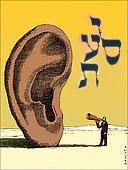 Here are some neat resources:
Here are some neat resources:Over the past few years, several WebSites have appeared that make the Hebrew Bible available to be heard read aloud. I think this is an especially nice resource for students of Biblical Hebrew to use at home to strongly beef up their pronunciation abilities. You can access the first such site here. It makes available audio recordings organized chapter-by-chapter through Bible. The files are provided by Audio Scriptures International and the United Bible Society, ©1976; they are not chanted with a melody, but are clearly pronounced in Sephardic-style
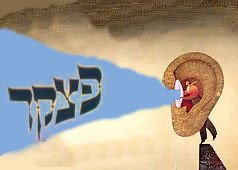 Hebrew. What I believe are the same files are also available here, at audioscriptures itself.
Hebrew. What I believe are the same files are also available here, at audioscriptures itself.Second, you can also hear the Torah read verse by verse at the Navigating the Bible site. Click on English --> Torah. You get the weekly Torah reading with Hebrew, translation, simple transliteration and chanting. Clicking on the little speaker icons by the verse numbers brings up RealPlayer and a voice chanting the verse in a very pleasant melody. Navigating the site can take some patience. Here is an acrobat chart that may help.
Wednesday, August 16, 2006
Genesis 31 and the Teraphim Figurines
 I mentioned in the last post that I am currently researching traditional African parallels to the role of the ancestral shades in the Hebrew Bible. Here is an artist's reconstruction of Gen 31:19, the shrine of the ancestors in the house of Laban, Rachel's father.
I mentioned in the last post that I am currently researching traditional African parallels to the role of the ancestral shades in the Hebrew Bible. Here is an artist's reconstruction of Gen 31:19, the shrine of the ancestors in the house of Laban, Rachel's father.Similar consecrated niches within one's homestead are known in several cultures, including traditional African cultures. The Baganda people, centered in Uganda, traditionally kept such shrines to the ancestors in each home. The presence of the family spirits helped bind the family together in mutual respect and concern. The spirits' permanent connection with the family homestead anchored the family physically on their family land.
Rachel doubtless stole the teraphim figurines so as not to sever this very type of traditional family bonding.
By the same token, Laban's outrage at the theft of the teraphim (Gen 31:30) was doubtless due to their inextricable connection with his ongoing family line and with his family's fields and houses. As among the Baganda, the family spirits must never leave the family homestead!
Tuesday, August 15, 2006
Bride "Price" or Bride "Wealth"?
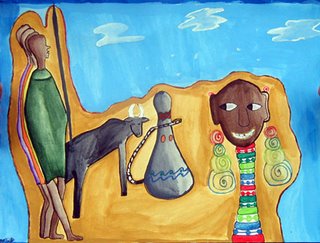 My current research has me delving into African religious practices as part of a paper for the upcoming SBL on the shades and the hereafter in the Hebrew Bible. (I'm sure I'll be posting on this research subsequently.) While reading an excellent book on African Religions and Philosophy by John S. Mbiti, I was reminded that often we westerners mis-apprehend the practice of bride wealth (cf. 1 Sam 18:27). Mbiti writes, "Under no circumstances is this custom a form of 'payment,' as outsiders have so often mistakenly said. ...The two families are involved in a relationship which, among other things, demands an exchange of material and other gifts. This continues even long after the girl is married and has her own children." Further, Mbiti writes, "This marriage gift...is a token of gratitude on the part of the bridegroom's people. ...At her home the gift 'replaces' her, reminding the family that she will leave or has left and yet she is not dead. She is a valuable person."
My current research has me delving into African religious practices as part of a paper for the upcoming SBL on the shades and the hereafter in the Hebrew Bible. (I'm sure I'll be posting on this research subsequently.) While reading an excellent book on African Religions and Philosophy by John S. Mbiti, I was reminded that often we westerners mis-apprehend the practice of bride wealth (cf. 1 Sam 18:27). Mbiti writes, "Under no circumstances is this custom a form of 'payment,' as outsiders have so often mistakenly said. ...The two families are involved in a relationship which, among other things, demands an exchange of material and other gifts. This continues even long after the girl is married and has her own children." Further, Mbiti writes, "This marriage gift...is a token of gratitude on the part of the bridegroom's people. ...At her home the gift 'replaces' her, reminding the family that she will leave or has left and yet she is not dead. She is a valuable person."
Monday, August 14, 2006
This video of Psalm 150 sung at St. Paul's Cathedral, London was posted to YouTube back in June. The perfomance dates to a thanksgiving service in 2002. John Rutter's setting of Psalm 150 was commissioned for the Queen's Golden Jubilee. It's amazing. Enjoy!
Sunday, August 13, 2006
Saturday, August 12, 2006
Servant Songs of Second Isaiah (2 of 3)

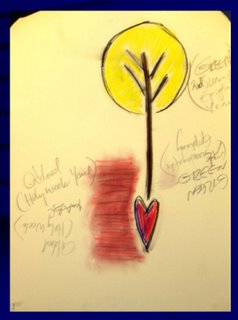
Friday, August 11, 2006
Student Project: The Suffering Servant (1 of 3)


The images reveal close attention to the poetic images of the Servant Songs, and provoked some great class discussion. I would welcome your observations.
Thursday, August 10, 2006
Update: Sudan Biblical Language Program
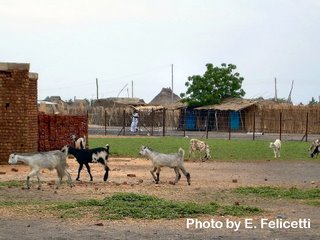
Jo has just emailed from Sudan:
Dear All,
I can send a newsbrief direct, thanks to Lauren's new system (excuse a random list of those addresses I can remember - do forward to others). Greetings to all, and thanks for all prayers. I'm aware of being buoyed up by them - almost half way through my time (it's flying by). My biggest concern - for the ability to deal with the heat - has been answered big time. It has been cloudy much of the last 3 days, with 24 hours of rain. Kind of English weather - which I've never appreciated so much before. Though England doesn't get so muddy. I've just completed my third day of teaching, 3 sessions per day. We've sped through 2000 years of history, chiefly from Augustine of Canterbury through the Reformation to the missionary movement. I'm pretty tired, but happily so - just so glad (and somewhat amazed) to have a class of people who are excited to learn about Anglicanism and asking GREAT questions. It felt like it started slowly, but the classhas now grown to 23 - two more arrived just as I FINISHED this afternoon - but I suppose I should be encouraged if the number is not diminishing. I appointed people to go over the last 3 days of material with them this evening. We'll see what happens. Perhaps it's the wind-up flashlights.
The Anglican/Episcopal students at Duke sent me with 50 (almost one suitcase-full) and I handed them out to my class yesterday along with copies of The 39 Articles and Lambeth-Chicago Quadrilateral to try reading. (The rest are gradually being distributed around the extended family who've welcomed me.) They are just thrilled with them - most haven't see wind-up ones before (nor me!). So there passed a hilarious five minutes during which some people thought it was a camera with flash, and others worked out how to use them - while I explained the link with Duke folks who have given as a token of their precious partnership with them in the gospel. They were touched. But - wait for it - it turns out what they became even more excited about was the little cable that is included in the box that allows the wind-up flashlight to recharge a cell phone. Amazingly the plug seems to fit their cell phones which most seem to have (and FAIL to switch off during class)... This is a strange world, where satellite technology has bypassed traditional infrastructure. I'd guess there are more computers than pit-latrines in this small town.
As I write this email, sitting in a coolbreeze in the 'peace' of the bishop's compound - on a pink plastic chair with various playful boys watching in fascination - there aregoats scavenging at the minimal vegetation. The 'kitchen' - a mud and reed structure with open sides - has just collapsed owing to the rainsand thus supper will be elsewhere tonight. Bishop Daniel is now in town and everyone is dancing. He's full of vision and very much loved - it's easy to see why. He also manages to charm a few more people back to their work, even when they haven't been paid in a while.
Life here is certainly basic - tougher than I've ever experienced before, even in Haiti - and, though I feel extremely safe, the peace is clearly very fragile. But the joy and laughter is equally striking, as is the longing of my students to learn their church history and engage with their 'cousins' (I've created an Anglican family tree) around theworld - once I can get them into the classroom. As they put it themselves, if they can understand their history then they will know better who they are, what they can offer to the Communion and be less likely to repeat the mistakes of their forebears. This afternoon, as we trotted through all the different Provinces of the Ang Communion, they were especially fascinated to talk about the united Churches of South India / North India / Pakistan / Bangladesh. Don't think it had crossed their minds that such ecumenical partnership was possible.
Well, I'm certainly learning more about who I am, and feel so proud tobe related to these strong, courageous, faithful people. Be warned that I may not stop talking about it on return.
With much love Jo
Wednesday, August 09, 2006
On the Way to Nineveh: Studies in Honor of George M Landes
 The book that we prepared in honor of George M. Landes on the occasion of his retirement from UTS is on sale for a limited time at Dove Booksellers. The essays in this book are well worth having, in my humble opinion, especially at this price, so check it out...
The book that we prepared in honor of George M. Landes on the occasion of his retirement from UTS is on sale for a limited time at Dove Booksellers. The essays in this book are well worth having, in my humble opinion, especially at this price, so check it out...
The Hebrew Bible at VTS (4)
 My last installment of this series on the history of the Bible at VTS was back on July 23rd. This installment (number 4) brings us up to the turn of the twentieth century, where we find the seminary faculty and board wrestling with the conflict in America over modernist biblical criticism.
My last installment of this series on the history of the Bible at VTS was back on July 23rd. This installment (number 4) brings us up to the turn of the twentieth century, where we find the seminary faculty and board wrestling with the conflict in America over modernist biblical criticism.The year was 1906 and the presenting issue was as follows. The seminary catalog was listing books representing modernist criticism of the Hebrew Bible (e.g., J. Wellhausen's and C. Brigg's reference books). The board of trustees asked for their removal. The members of the board did not want the catalog to give the impression that VTS endorced the findings of the modernist approach. (Interesting how then as now, people jump to assume that if a professor assigns a book, he or she agrees with its views!)
One of the books the board wanted out of the catalog was Job and Solomon by the Rev. T. K. Cheyne (London, 1887). Cheyne, professor of interpretation at Oxford and canon of Rochester, was a prolific biblical scholar, whose work squarely represented the rising historical critical approach to the Hebrew Bible that was soon to dominate the guild of biblical studies.

Tuesday, August 08, 2006
Working on MAR-SBL WebSpace

Monday, August 07, 2006
Sunday, August 06, 2006
Update: Biblical Language Program in Renk, Sudan
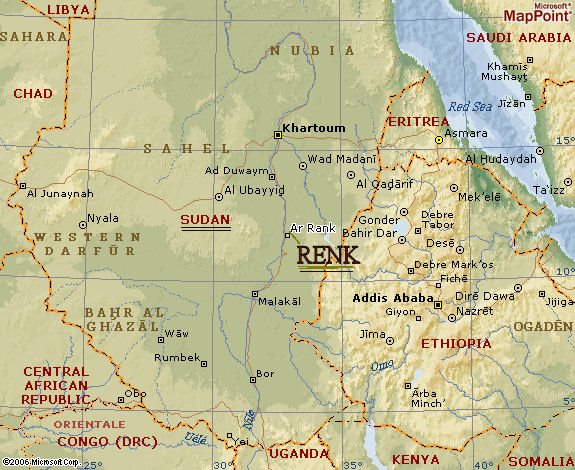
Just received an update on Jo Bailey Wells mission to Renk:
Jo is well. She is safely in Renk, after an air conditioned bus ride down the newly tarmacked road from Khartoum. The weather is comparable to North Carolina, but without the humidity. She is 'a mile from the Nile'. Everyone is very tall, but extraordinarily friendly. She is not allowed to go out of the compound on her own, but she feels very comfortable in the local priest's dwelling place. Classes start on Monday, and a cathedral service awaits in the morning; preaching will wait till next weekend. Her main energies are focused on a book her Duke colleague Susan Eastman gave her just as she set off - a collection of letters home from a nineteenth century missionary - which is completely absorbing. A reassuring sight is the ubiquity of Duke T shirts - proudly worn by many of the people she meets. Truly a global brand.
Here is a beautiful photo of the new Renk Cathedral that Elizabeth F. gave me a few days ago, beautifully framed, after her mission to Renk. These are the natural colors at the time of the evening:
Saturday, August 05, 2006
A Good Testimonial
 I recently came across a blog with a great testimonial to the value of being serious about Hebrew and Greek at seminary.
I recently came across a blog with a great testimonial to the value of being serious about Hebrew and Greek at seminary.The author has taken a year of Hebrew and is currently taking Greek in an intensive summer session. She is pouring herself into both languages with a passion. You can see the actual blog entry in question here. Here are a few excerpts:
...It’s been absolutely phenomenal. It’s opened up the Scriptures like never before. There is far more than I can possibly take in. I’m constantly seeing new things—some are theologically significant and others are just interesting...
...There is such a fullness in Scripture that I want to see as much of it as possible, not to rely on the product of another [person]’s interpretation. I may often arrive at the same conclusions, but I still want to get there on my own. Plus I just love spending time with God in [God']s word. I can never get enough of reading and studying Scripture. This is why I’m willing to wake up before 3:00 in the morning and drive over two hours every day to attend Greek classes before a full day’s work.
Friday, August 04, 2006
Newsweek: Rabbi Marc Gellman on Mel Gibson
 Rabbi Marc Gellman has devoted his most recent column to Mel Gibson and his recent arrest. The essay is entitled, "Driving While Anti-Semitic." I think it is worth reading. Is "Mad Mel's" repentance genuine? An interesting test has been proposed by a certain Rabbi Boteach. He suggests that the best way for Mel to prove his apology is real would be to attach the following disclaimer to all future releases of his movie, The Passion:
Rabbi Marc Gellman has devoted his most recent column to Mel Gibson and his recent arrest. The essay is entitled, "Driving While Anti-Semitic." I think it is worth reading. Is "Mad Mel's" repentance genuine? An interesting test has been proposed by a certain Rabbi Boteach. He suggests that the best way for Mel to prove his apology is real would be to attach the following disclaimer to all future releases of his movie, The Passion:The Romans killed Jesus, and that any of the Jewish leadership, like Caiaphas the High Priest, who called for Jesus’ death were all in the employ of Rome, and indeed served as the Roman police enforcers in Judea.Comments on any of this (Rabbi Gellman? Mel Gibson? The Passion?) are welcome...
Archaeological Sites at Risk in both Lebanon and Israel
I need not tell you how badly we all feel about the current situation in the Middle East. We mourn the loss of human life, the suffering of
 civilians on both sides of the border, and pray that our leaders will beable to bring an end to the bloodshed soon. The impact on archaeology and the cultural heritage of this important area has been significant and on Friday July 21st the AIA and ASOR released a statement to the press callingon all combatants to honor the Hague Convention of 1954, which calls forparties in armed conflict to minimize damage to cultural sites. The joint press release was picked up by many papers and news outlets and appeared inthe New York Times as well as the Atlanta Constitution. The full text of the release was also posted on the AIA and ASOR web sites. What the long term impact of the current crisis will haveon research opportunities in the area and field experiences remains to beseen, but from the vantage point of late July, it does not look good. ASOR and its regional centers are functioning as of this writing and continuing what they do best, promoting scholarship and dialogue on the cultural heritage of the Middle East in all periods and settings, both material and written.
civilians on both sides of the border, and pray that our leaders will beable to bring an end to the bloodshed soon. The impact on archaeology and the cultural heritage of this important area has been significant and on Friday July 21st the AIA and ASOR released a statement to the press callingon all combatants to honor the Hague Convention of 1954, which calls forparties in armed conflict to minimize damage to cultural sites. The joint press release was picked up by many papers and news outlets and appeared inthe New York Times as well as the Atlanta Constitution. The full text of the release was also posted on the AIA and ASOR web sites. What the long term impact of the current crisis will haveon research opportunities in the area and field experiences remains to beseen, but from the vantage point of late July, it does not look good. ASOR and its regional centers are functioning as of this writing and continuing what they do best, promoting scholarship and dialogue on the cultural heritage of the Middle East in all periods and settings, both material and written.As Kevin Wilson has pointed out in his blog, updates and pictures of the situation at the various digs are updated at the BAS site.
Thursday, August 03, 2006
Isaiah 55 Set to Music (Canticle 10)

Here is another student project from my 2-Isaiah class, OT-206, Spring 2005. Rosemary Beales has set Isaiah 55:6-11, the Second Song of Isaiah, as a metrical version that can be sung to a hymn tune. The tune she chose was Blaenhafren, a Welsh folk tune, 1982 Hymnal # 610. I think the results that she achieved work rather well. They are based on hard work, exegesis, and artistic talent.
You can see her version (and her research) here.
You can hear the tune as a MIDI audio file here.


